State of the Art Review about Bio-Inspired Design and Applications: An Aerospace Perspective
Abstract
1. Introduction
2. Review on Materials Used in Bio-Inspired Design
3. Review on Manufacturing Methods Used in Bio-Inspired Design
4. Applications of Bio-Inspiration in the Aerospace Industry
- (a)
- Wing designs
- (b) Sensors
- (c) Structures
5. Conclusions
Author Contributions
Funding
Institutional Review Board Statement
Informed Consent Statement
Acknowledgments
Conflicts of Interest
References
- Maxwell, J.C. Statique expérimentale et théorique des Liquides soumis aux seules Forces moléculaires. Nature 1874, 10, 119–121. [Google Scholar] [CrossRef]
- Tucker, V.A.; Parrott, C.G. Aerodynamics of gliding flight in a falcon and other birds. J. Exp. Biol. 1970, 52, 2345–2367. [Google Scholar] [CrossRef]
- Norberg, U.M.; Rayner, J.M. Philosophical Transactions of the Royal Society of London. Biol. Sci. 1987, 316, 335–427. [Google Scholar]
- Gerdes, P. Variazioni sui disegni Lunda. In Matematica e Cultura; Springer Science & Business Media: Berlin, Germany, 2002; pp. 135–146. [Google Scholar]
- Harkness, J.M. In Appreciation A Lifetime of Connections: Otto Herbert Schmitt, 1913–1998. Phys. Perspect. 2002, 4, 456–490. [Google Scholar] [CrossRef]
- Ruffier, F.; Viollet, S.; Franceschini, N. OSCAR and OCTAVE: Two bioinspired visually guided aerial microrobots. In Proceedings of the IEEE 11th International Conference on Advanced Robotics(ICAR), Coimbra, Portugal, 30 June–3 July 2003; pp. 726–732. [Google Scholar]
- Franceschini, N.; Ruffier, F.; Serres, J. A bio-inspired flying robot sheds light on insect piloting abilities. Curr. Biol. 2007, 17, 329–335. [Google Scholar] [CrossRef]
- Rosen, D.W. Design for Additive Manufacturing: A Method to Explore Unexplored Regions of the Design Space. In Proceedings of the 2007 International Solid Freeform Fabrication Symposium, Austin, TX, USA, 2007; Available online: https://repositories.lib.utexas.edu/bitstream/handle/2152/80208/2007-34-Rosen.pdf?sequence=2&isAllowed=y (accessed on 28 May 2021).
- McDonald, M.; Agrawal, S.K. Design of a bio-inspired spherical four-bar mechanism for flapping-wing micro air-vehicle applications. J. Mech. Robot. 2010, 2, 021012. [Google Scholar] [CrossRef]
- Li, F.; Liu, W.; Stefanini, C.; Fu, X.; Dario, P. A novel bioinspired PVDF micro/nano hair receptor for a robot sensing system. Sensors 2010, 10, 94–1011. [Google Scholar] [CrossRef]
- Viollet, S.; Ruffier, F.; Ray, T.; Menouni, M.; Aubépart, F.; Kerhuel, L.; Franceschini, N. Characteristics of three miniature bioinspired optic flow sensors in natural environments. In Proceedings of the 2010 Fourth International Conference on Sensor Technologies and Applications, Venice, Italy, 18–25 July 2010; pp. 51–55. [Google Scholar]
- Nguyen, Q.V.; Park, H.C.; Goo, N.S.; Byun, D. Characteristics of abeetle’s free flight and aflapping-wing system that mimics beetleflight. J. Bionic Eng. 2010, 7, 77–86. [Google Scholar] [CrossRef]
- Coelho, D.A.; Versos, C.A.M. An approach to validation of technological industrial design concepts with a bionic character. In Proceedings of the International Conferenceon Designand Product Development(ICDPD’10), Athens, Greece, 29–31 December 2010; pp. 29–31. [Google Scholar]
- Emmelmann, C.; Sander, P.; Kranz, J.; Wycisk, E. Laser Additive Manufacturing and Bionics: Redefining Lightweight Design. Phys. Procedia 2011, 12, 364–368. [Google Scholar] [CrossRef]
- Liu, K.; Jiang, L. Bio-inspired design of multiscale structures for function integration. Nano Today 2011, 6, 155–175. [Google Scholar] [CrossRef]
- Glier, M.W.; Tsenn, J.; Linsey, S.J.; McAdams, A.D. Methods for supporting bioinspired design. In Proceedings of the ASME International Mechanical Engineering Congress and Exposition, Denver, CO, USA, 11–17 November 2011; pp. 737–744. [Google Scholar]
- Wrigley, C.; Bucolo, S. Teaching Design Led Innovation: The future of industrial design. Des. Princ. Pract. 2011, 5, 231–239. [Google Scholar] [CrossRef]
- Trotta, M.G. Bio-inspired Design Methodology. Int. J. Inf. Sci. 2011, 1, 1–11. [Google Scholar] [CrossRef]
- Versos, C.A. Biologically inspired design: Methods and validation. In Industrial Design-New Frontiers; Coelho, D.A., Ed.; University of Beira Interior: Covilhã, Portugal, 2011. [Google Scholar]
- Xu, L.P.; Peng, J.; Liu, Y.; Wen, Y.; Zhang, X.; Jiang, L.; Wang, S. Nacre inspired design of mechanical stable coating with under water superoleophobicity. Acs Nano. 2013, 7, 5077–5083. [Google Scholar] [CrossRef]
- Lin, S.; Ryu, S.; Tokareva, O.; Gronau, G.; Jacobsen, M.M.; Huang, W.; Rizzo, D.J. Predictive modelling-based design and experiments for synthesis and spinning of bioinspired silk fibres. Nat. Commun. 2015, 6, 1–12. [Google Scholar] [CrossRef]
- Connors, M.; Yang, T.; Hosny, A.; Deng, Z.; Yazdandoost, F.; Massaadi, H.; Eernisse, D.; Mirzaeifar, R.; Dean, M.N.; Weaver, J.C.; et al. Bioinspired design of flexible armor based on chiton scales. Nat. Commun. 2019, 10, 1–13. [Google Scholar] [CrossRef]
- Zhang, B.; Han, Q.; Zhang, J.; Han, Z.; Niu, S.; Ren, L. Advancedbio-inspired structural materials: Local properties determine overall performance. Mater. Today 2020, 41, 177–199. [Google Scholar] [CrossRef]
- Gu, G.X.; Su, I.; Sharma, S.; Voros, J.L.; Qin, Z.; Buehler, M.J. Three-Dimensional-Printing of Bio-Inspired Composites. J. Biomech. Eng. 2016, 138, 021006–02100616. [Google Scholar] [CrossRef]
- Burns, L.; Mouritz, A.; Pook, D.; Feih, S. Bio-inspired design of aerospace composite joints for improved damage tolerance. Compos. Struct. 2012, 94, 995–1004. [Google Scholar] [CrossRef]
- Xiang, J.; Du, J. Energy absorption characteristics of bio-inspired honeycomb structure under axial impact loading. Mater. Sci. Eng. A 2017, 696, 283–289. [Google Scholar] [CrossRef]
- Feng, X.; Yang, Z.; Rostom, S.S.; Dadmun, M.; Wang, S.; Wang, Q.; Xie, Y. Reinforcing 3D printed acrylonitrile butadiene styrene by impregnation of methacrylate resin and cellulose nanocrystal mixture: Structural effects and homogeneous properties. Mater. Des. 2018, 138, 62–70. [Google Scholar] [CrossRef]
- Hogan, A.V.; Xu, J.; Meyers, M.A. Additive manufacturing as a method to design and optimize bioinspired structures. Adv. Mater. 2018, 52, 1800940. [Google Scholar] [CrossRef] [PubMed]
- Li, B.; Tan, H.; Anastasova, S.; Power, M.; Florent, S.; Guang-Zhong, Y. Abio-inspired3Dmicro-structureforgraphene-basedbacteriasensing. Biosens. Bioelectron. 2019, 123, 77–84. [Google Scholar] [CrossRef]
- Liu, L.; Xu, Y.; Xu, M.; He, Y.; Li, S.; Li, B. An efficient synergistic system for simultaneously enhancing the fire retardancy, moisture resistance and electrical insulation performance of unsaturated polyester resins. Mater. Des. 2020, 187, 108302. [Google Scholar] [CrossRef]
- Huang, G.; Zhu, Y.; Liao, Z.-Y.; Huang, Z.; Jiang, P.-X. Transpiration cooling with bio-inspired structured surfaces. Bioinspiration Biomim. 2020, 15, 036016. [Google Scholar] [CrossRef]
- Rahim, A.A.; Musa, S.N.; Ramesh, S.; Lim, M.K. A systematic review on material selection methods. Proc. Inst. Mech. Eng. Part L: J. Mater. Des. Appl. 2020, 234, 1032–1059. [Google Scholar] [CrossRef]
- Wang, Y.; Li, M.; Lu, W.; Gu, Y.; Wang, S.; Sun, R.; Zhang, X.; Li, Q.; Zhang, Z. Bio-inspired design and fabrication of an ultralight and strong nano-carbon gradient composite. Mater. Des. 2016, 107, 198–204. [Google Scholar] [CrossRef]
- Arenas, J.M.; Alia, C.; Blaya, F.; Sanz, A. Multi-criteria selection of structural adhesives to bond ABS parts obtained by rapid prototyping. Int. J. Adhes. Adhes. 2012, 33, 67–74. [Google Scholar] [CrossRef]
- Fratzl, P.; Dunlop, J.W.C.; Weinkamer, R. Materials Design Inspired by Nature: Function through Inner Architecture; Royal Society of Chemistry: London, UK, 2015. [Google Scholar]
- LuQuan, R.; XiuJuan, L. Functional characteristics of dragonfly wings and its bionic investigation progress. Sci. China Technol. Sci. 2013, 56, 884–897. [Google Scholar]
- Aziz, M.S.; ElSherif, A.Y. Biomimicryasanapproachforbio-inspired structure with the aid of computation. Alex. Eng. J. 2016, 55, 707–714. [Google Scholar] [CrossRef]
- Yang, S.; Zhao, Y.F. Additive manufacturing-enabled design theory and methodology: A critical review. Int. J. Adv. Manuf. Technol. 2015, 80, 327–342. [Google Scholar] [CrossRef]
- Yue, H.; Yao, L.; Gao, X.; Zhang, S.; Guo, E.; Zhang, H.; Lin, X.; Wang, B. Effectofball-milling and graphene contents on the mechanical properties and fracture mechanisms of graphene nano sheets reinforced copper matrix composites. J. Alloys Compd. 2017, 69, 755–762. [Google Scholar] [CrossRef]
- Duigou, A.L.; Requile, S.; Beaugrand, J.; Scarpa, F.; Castro, M. Natural fibres actuators for smart bio-inspired hydromorph biocomposites. Smart Mater. Struct. 2017, 26, 125009. [Google Scholar] [CrossRef]
- Cattenone, A.; Morganti, S.; Alaimo, G.; Auricchio, F. Finite element analysis of additive manufacturing based on fused deposition modeling: Distortions prediction and comparison with experimental data. J. Manuf. Sci. Eng. 2019, 141, 011010. [Google Scholar] [CrossRef]
- Zhang, H.; Nagel, K.N.; Al-Qas, A.; Gibbons, E.; Lee, J.J.Y. Additive manufacturing with bioinspired sustainable product design: A conceptual model. Procedia Manuf. 2018, 26, 880–891. [Google Scholar] [CrossRef]
- Sarvestani, H.Y.; Mirkhalaf, M.; Akbarzadeh, A.; Backman, D.; Genest, M.; Ashrafi, B. Multilayered architectured ceramic panels with weak interfaces: Energy absorption and multi-hit capabilities. Mater. Des. 2019, 167, 107627. [Google Scholar] [CrossRef]
- Neveu, F.; Castanié, B.; Olivier, P. The GAP methodology: A new way to design composite structures. Mater. Des. 2019, 172, 107755. [Google Scholar] [CrossRef]
- Zhang, Z.; Lei, H.; Xu, M.; Hua, J.; Li, C.; Fang, D. Out-of-plane compressive performance and energy absorption of multi-layer graded sinusoidal corrugated sandwich panels. Mater. Des. 2019, 178, 107858. [Google Scholar] [CrossRef]
- Kaminski, M.; Loth, E.; Griffith, D.T.; Qin, C. (Chris) Ground testing of a 1% gravo-aeroelastically scaled additively-manufactured wind turbine blade with bio-inspired structural design. Renew. Energy 2020, 148, 639–650. [Google Scholar] [CrossRef]
- Yang, E.; Leary, M.; Lozanovski, B.; Downing, D.; Mazur, M.; Sarker, A.; Khorasani, A.; Jones, A.; Maconachie, T.; Bateman, S.; et al. Effect of geometry on the mechanical properties of Ti-6Al-4V Gyroid structures fabricated via SLM: A numerical study. Mater. Des. 2019, 184, 108165. [Google Scholar] [CrossRef]
- Sun, Y.; Tian, W.; Zhang, T.; Chen, P.; Li, M. Strength and toughness enhancement in 3d printing via bioinspired tool path. Mater. Des. 2020, 185, 108239. [Google Scholar] [CrossRef]
- Xiang, X.; Zou, S.; Ha, N.S.; Lu, G.; Kong, I. Energy absorption of bio-inspired multi-layered graded foam-filled structures under axial crushing. Compos. Part B Eng. 2020, 198, 108216. [Google Scholar] [CrossRef]
- Jia, Z.; Yu, Y.; Wang, L. Learning from nature: Use material architecture to break the performance tradeoffs. Mater. Des. 2019, 168, 107650. [Google Scholar] [CrossRef]
- Plaschke, L.; Vezzoli, C.; Scullica, F. Product Design for Sustainability –Guidelines for the Life Cycle Design of Office Furniture. In Proceedings of the 3rd LeNS World Distributed Conference, Mexico City, Mexico, Curitiba, Brasil, Cape Town, South Africa, Bangalore, India, Beijing, China, Milan, Italy, 3–5 April 2019; pp. 915–919. Available online: https://www.researchgate.net/publication/339745792 (accessed on 28 May 2021).
- Wang, D.; Dongdong, C.; Zeyu, C. Recent progress in 3D printing of bioinspired structures. Front. Mater. 2020, 7, 286. [Google Scholar] [CrossRef]
- Kalantari, S.; Adimi, N.; Zarkesh, A. Connections between mathematics, bionic and architecture through minimal surfaces: Fabricate minimal surfaces digitally for architectural application via computational design. Proceedingsof the 2nd International Congress on Science and Engineering, Paris, France, 21 August 2020. [Google Scholar]
- Ma, W.; Xie, S.; Li, Z. Mechanical performance of bio-inspired corrugated tubes with varying vertex configurations. Int. J. Mech. Sci. 2020, 172, 105399. [Google Scholar] [CrossRef]
- Du, Y.; Gu, D.; Xi, L.; Dai, D.; Gao, T.; Zhu, J.; Ma, C. Laser additive manufacturing of bio-inspired lattice structure: Forming quality, microstructure and energy absorption behavior. Mater. Sci. Eng. A 2020, 773, 138857. [Google Scholar] [CrossRef]
- Essassi, K.; Rebiere, J.-L.; El Mahi, A.; Ben Souf, M.A.; Bouguecha, A.; Haddar, M. Experimental and analytical investigation of the bending behaviour of 3D-printed bio-based sandwich structures composites with auxetic core under cyclic fatigue tests. Compos. Part A Appl. Sci. Manuf. 2020, 131, 105775. [Google Scholar] [CrossRef]
- Zhu, H.; Li, D.-S.; Han, W.-F.; Jiang, L. Experimental and numerical study of in-plane compressive properties and failure of 3D six-directional braided composites with large braiding angle. Mater. Des. 2020, 195, 108917. [Google Scholar] [CrossRef]
- Yang, F.; Xie, W.; Meng, S. Impact and blast performance enhancement in bio-inspired helicoidal structures: A numerical study. J. Mech. Phys. Solids 2020, 142, 104025. [Google Scholar] [CrossRef]
- Díaz-Tena, E.; Barona, A.; Gallastegui, G.; Rodríguez, A.; De Lacalle, L.N.L.; Elías, A. Biomachining: Metal etching via microorganisms. Crit. Rev. Biotechnol. 2016, 37, 323–332. [Google Scholar] [CrossRef]
- Díaz-Tena, E.; Gallastegui, G.; Hipperdinger, M.; Donati, E.; Ramírez, M.; Rodríguez, A.; de Lacalle, L.L.; Elías, A. New advances in copper biomachining by iron-oxidizing bacteria. Corros. Sci. 2016, 112, 385–392. [Google Scholar] [CrossRef]
- Ferrand, L.H.; Bouville, F.; Niebel, T.P.; Studart, A.R. Magnetically assisted slip casting of bioinspired heterogeneous composites. Nat. Mater. 2015, 14, 1172–1179. [Google Scholar] [CrossRef]
- Abdulrahim, M.; Lind, R. Flight testing and response characteristics of a variable gull-wing morphing aircraft. In Proceedings of the AIAA Guidance, Navigation, and Control Conference and Exhibit, Providence, RI, USA, 16–19 August 2004; p. 5113. [Google Scholar]
- Jones, K.D.; Bradshaw, C.J.; Papadopoulos, J.; Platzer, M.F. Bio-inspired design of flapping-wings microair vehicles. Aeronaut. J. 2005, 109, 385–393. [Google Scholar] [CrossRef]
- Fish, F.E.; Weber, P.W.; Murray, M.M.; Howle, L.E. The Tubercles on Humpback Whales’ Flippers: Application of Bio-Inspired Technology. Integr. Comp. Biol. 2011, 51, 203–221. [Google Scholar] [CrossRef] [PubMed]
- Nychka, J.A.; Chen, P.-Y. Natureas Inspirationin Materials Science and Engineering. JOM 2012, 64, 446–448. [Google Scholar] [CrossRef]
- Galantai, V.P.; Sofla, A.Y.N.; Meguid, S.A.; Tan, K.T.; Yeo, W.K. Bio-inspired wing morphing for unmanned aerial vehicles using intelligent materials. Int. J. Mech. Mater. Des. 2011, 8, 71–79. [Google Scholar] [CrossRef]
- Hassanalian, M.; Throneberry, G.; Abdelkefi, A. Wing shape and dynamic twist design of bio-inspired nano air vehicles for forward flight purposes. Aerosp. Sci. Technol. 2017, 68, 518–529. [Google Scholar] [CrossRef]
- Van Truong, T.; Nguyen, Q.-V.; Lee, H.P. Bio-Inspired Flexible Flapping Wings with Elastic Deformation. Aerospace 2017, 4, 37. [Google Scholar] [CrossRef]
- Bluman, J.E.; Pohly, J.A.; Sridhar, M.K.; Kang, C.-K.; Landrum, D.B.; Fahimi, F.; Aono, H. Achieving bioinspired flapping wing hovering flight solutions on Mars via wing scaling. Bioinspiration Biomim. 2018, 13, 046010. [Google Scholar] [CrossRef] [PubMed]
- Lu, Z.; DeBiasi, M.; Nguyen, Q.-V.; Chan, W.-L. Bioinspired Low-Noise Wing Design for a Two-Winged Flapping-Wing Micro Air Vehicle. AIAA J. 2018, 56, 4697–4705. [Google Scholar] [CrossRef]
- Ito, M.R.; Duan, C.; Wissa, A.A. The function of the alulaon engineered wings: A detailed experimental investigation of a bioinspired leading-edge device. Bioinspiration Biomim. 2019, 14, 056015. [Google Scholar] [CrossRef]
- Hui, Z.; Zhang, Y.; Chen, G. Aerodynamic performance investigation on a morphing unmanned aerial vehicle with bio-inspired discrete wing structures. Aerosp. Sci. Technol. 2019, 95, 105419. [Google Scholar] [CrossRef]
- Dwivedi, Y.D.; Bhargava, V. Aerodynamic characterization of bio inspired corrugated wings. Moj. App. Bio. Biomech. 2019, 3, 1–10. [Google Scholar]
- Abbasi, S.H.; Mahmood, A. Modeling, Simulation and Control of a Bio-Inspired Electromechanical Feather for Gust Mitigation in Flapping Wing UAV. In Proceedings of the 2019 2nd International Conference on Communication, Computing and Digital systems (C-CODE), Institute of Electrical and Electronics Engineers (IEEE), Islamabad, Pakistan, 6–7 March 2019; pp. 195–200. [Google Scholar]
- Sihite, E.; Kelly, P.; Ramezani, A. Computational structure design of a bio-inspired armwing mechanism. IEEE Robot. Autom. Lett. 2020, 5, 5929–5936. [Google Scholar] [CrossRef]
- Meng, L.; Lan, X.; Zhao, J.; Wang, Z. Equivalent models and mechanical properties of bio-inspired corrugated sandwich structures subjected to bending loads. Compos. Struct. 2020, 244, 112257. [Google Scholar] [CrossRef]
- Fronczek, J.W.; Nadipuram, R.P. Bio-inspired sensor swarms to detect leaks in pressurized systems. In Proceedings of the 2005 IEEE International Conference on Systems, Man and Cybernetics, Waikoloa, HI, USA, 12 October 2005, Volume.2; pp. 1967–1972.
- Zufferey, J.C.; Floreano, D. Fly-inspired visual steering of an ultralight indoor aircraft. IEEE Trans. Robot. 2006, 22, 137–146. [Google Scholar] [CrossRef]
- Juston, R.; Viollet, S.; Kerhuel, L.; Franceschini, N. High performance optical angular position sensing at low-cost: A bio-inspired approach. In Proceedings of the 2011 IEEE SENSORS Proceedings; Institute of Electricaland Electronics Engineers (IEEE), Limerick, Ireland, 28–31 October 2011; pp. 378–381. [Google Scholar]
- Marefat, F.; Partovi, A.; Mousavinia, A. A hemispherical omni-directional bioinspired optical sensor. In Proceedings of the 20th Iranian Conference on Electrical Engineering (ICEE2012), Tehran, Iran, 15–17 May 2012; pp. 668–672. [Google Scholar]
- Kerhuel, L.; Viollet, S.; Franceschini, N. The VODKA Sensor: ABio-Inspired Hyperacute Optical Position Sensing Device. IEEE Sens. J. 2011, 12, 315–324. [Google Scholar] [CrossRef]
- Wood, K.T.; Estrada, S.A.; Richardson, T.; Windsor, S. Distributed Pressure Sensing–Based Flight Control for Small Fixed-Wing Unmanned Aerial Systems. J. Aircr. 2019, 56, 1951–1960. [Google Scholar] [CrossRef]
- Mohamed, A.; Watkins, S.; Fisher, A.; Marino, M.; Massey, K.; Clothier, R. Bioinspiredwing -surface pressure sensing for attitude control of micro air vehicles. J. Aircr. 2015, 52, 827–838. [Google Scholar] [CrossRef]
- Araujo-Estrada, S.A.; Salama, F.; Greatwood, C.M.; Wood, K.T.; Richardson, T.S.; Windsor, S.P. Bio-inspired Distributed Strain and Airflow Sensing for Small Unmanned Air Vehicle Flight Control. In Proceedings of the AIAA Guidance, Navigation, and Control Conference, American Institute of Aeronautics and Astronautics (AIAA), GrapeVine, TX, USA, 9–13 January 2017; p. 1487. [Google Scholar]
- Ren, Z.; Fu, W.; Zhu, S.; Yan, B.; Yan, J. Bio-inspired neural adaptive control of a small unmanned aerial vehicle based on airflow sensors. Sensors 2018, 18, 3233. [Google Scholar] [CrossRef] [PubMed]
- Zhao, J.; Hu, C.; Zhang, C.; Wang, Z.; Yue, S. A bio-inspired collision detector for small quadcopter. In Proceedings of the 2018 International Joint Conference on Neural Networks (IJCNN), Riode Janeiro, Brazil, 8–13 July 2018; pp. 1–7. [Google Scholar]
- Frost, S.A.; Yates, L.A.; Kumagai, H.S. Bioinspired Optical Sensor for Remote Measurement of Small Displacements at a Distance. Biomimetics 2018, 3, 34. [Google Scholar] [CrossRef]
- Park, S.; Lee, K.; Song, H.; Cho, J.; Park, S.-Y.; Yoon, E. Low-Power, Bio-Inspired Time-Stamp-Based 2-D Optic Flow Sensor for Artificial Compound Eyes of Micro Air Vehicles. IEEE Sensors J. 2019, 19, 12059–12068. [Google Scholar] [CrossRef]
- Gavrilović, N.; Bronz, M.; Moschetta, J.-M. Bioinspired Energy Harvesting from Atmospheric Phenomena for Small Unmanned Aerial Vehicles. J. Guid. Control. Dyn. 2020, 43, 685–699. [Google Scholar] [CrossRef]
- Estrada, A.; Sergio, A.; Windsor, S.P. Aerodynamic State and Loads Estimation Using Bioinspired Distributed Sensing. J. Aircr. 2020, 1–13. [Google Scholar] [CrossRef]
- Pandremenos, J.; Vasiliadis, E.; Chryssolouris, G. Design architectures in biology. In Proceedings of the 3rd CIRP Conferenceon Biomanufacturing, Athens, Greece, 16–18 May 2012; pp. 448–452. [Google Scholar]
- Zhao, J.; Yan, S.; Deng, L.; Huang, H.; Liu, Y. Design and analysis of biomimetic nose cone for morphing of aerospace vehicle. J. Bionic Eng. 2017, 14, 317–326. [Google Scholar] [CrossRef]
- Dai, H.; Jing, X.; Wang, Y.; Yue, X.; Yuan, J. Post-capture vibration suppression of spacecraft via abio-inspired isolation system. Mech. Syst. Signal. Process. 2018, 105, 214–240. [Google Scholar] [CrossRef]
- Le, V.T.; Goo, N.M. Thermomechanical performance of bio-inspired corrugated -core sandwich structure for a thermal protection system panel. Appl. Sci. 2019, 24, 5541. [Google Scholar] [CrossRef]
- Sherman, M.; Hassanalian, M.; Bradley, S. Dandelion-Inspired Micro-Rovers: Novel Concept of Extraterrestrial Systems forMars Exploration. In Proceedings of the AIAA AVIATION 2020 FORUM, VirtualEvent, 15–19 June 2020. [Google Scholar] [CrossRef]
- Zhang, R.; Pang, H.; Ji, Q.; Li, G.; Dong, W.; Wen, L.; Li, J. Structure design and traction trafficability analysis of multi-posture wheel-legs bionic walking wheels for sand terrain. J. Terramechanics 2020, 91, 31–43. [Google Scholar] [CrossRef]
- Dai, H.; Cao, X.; Jing, X.; Wang, X.; Yue, X. Bio-inspired anti-impact manipulator for capturing non-cooperative spacecraft: Theory and experiment. Mech. Syst. Signal Process. 2020, 142, 106785. [Google Scholar] [CrossRef]
- Vernerey, F.J.; Barthelat, F. Skin and scales of teleost fish: Simple structure but high performance and multiple functions. J. Mech. Phys. Solids 2014, 68, 66–76. [Google Scholar] [CrossRef]

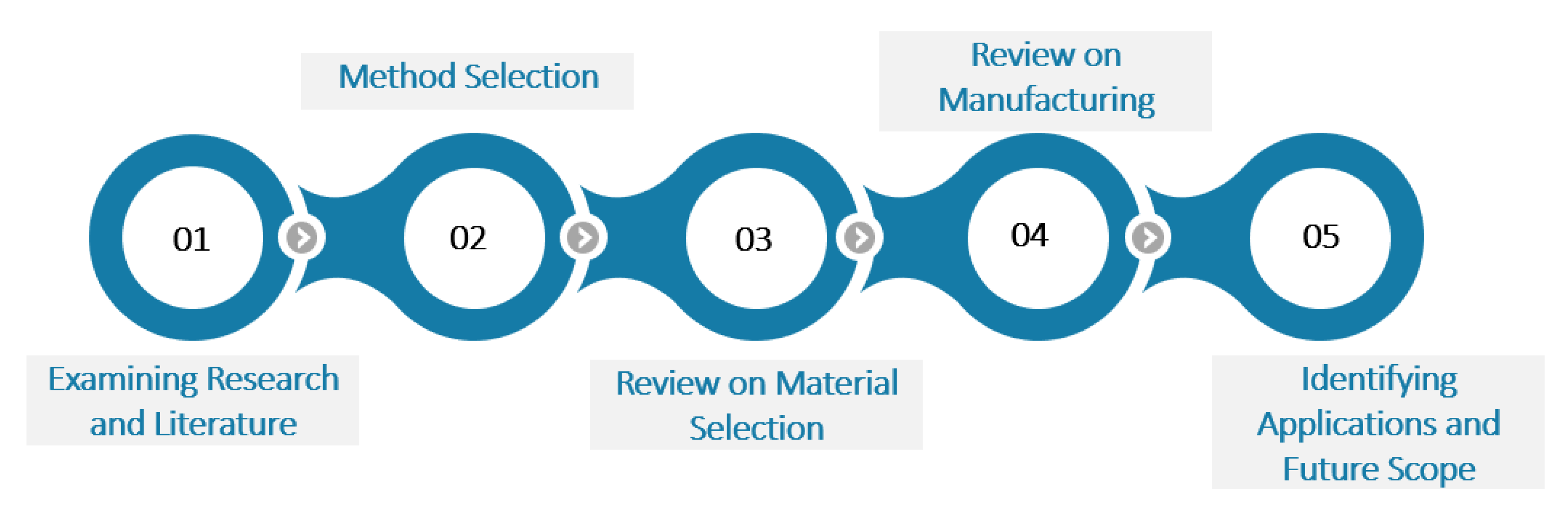



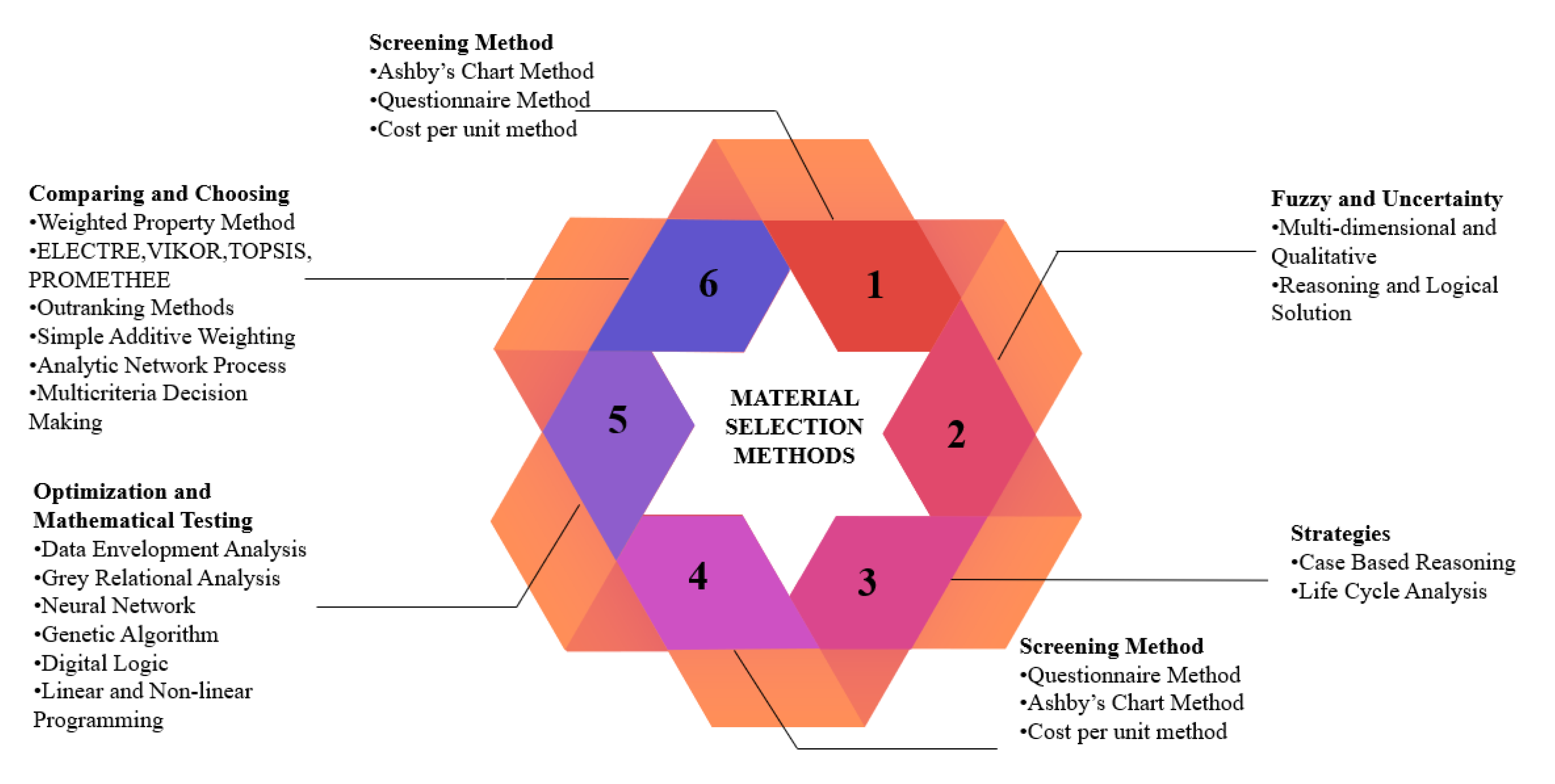
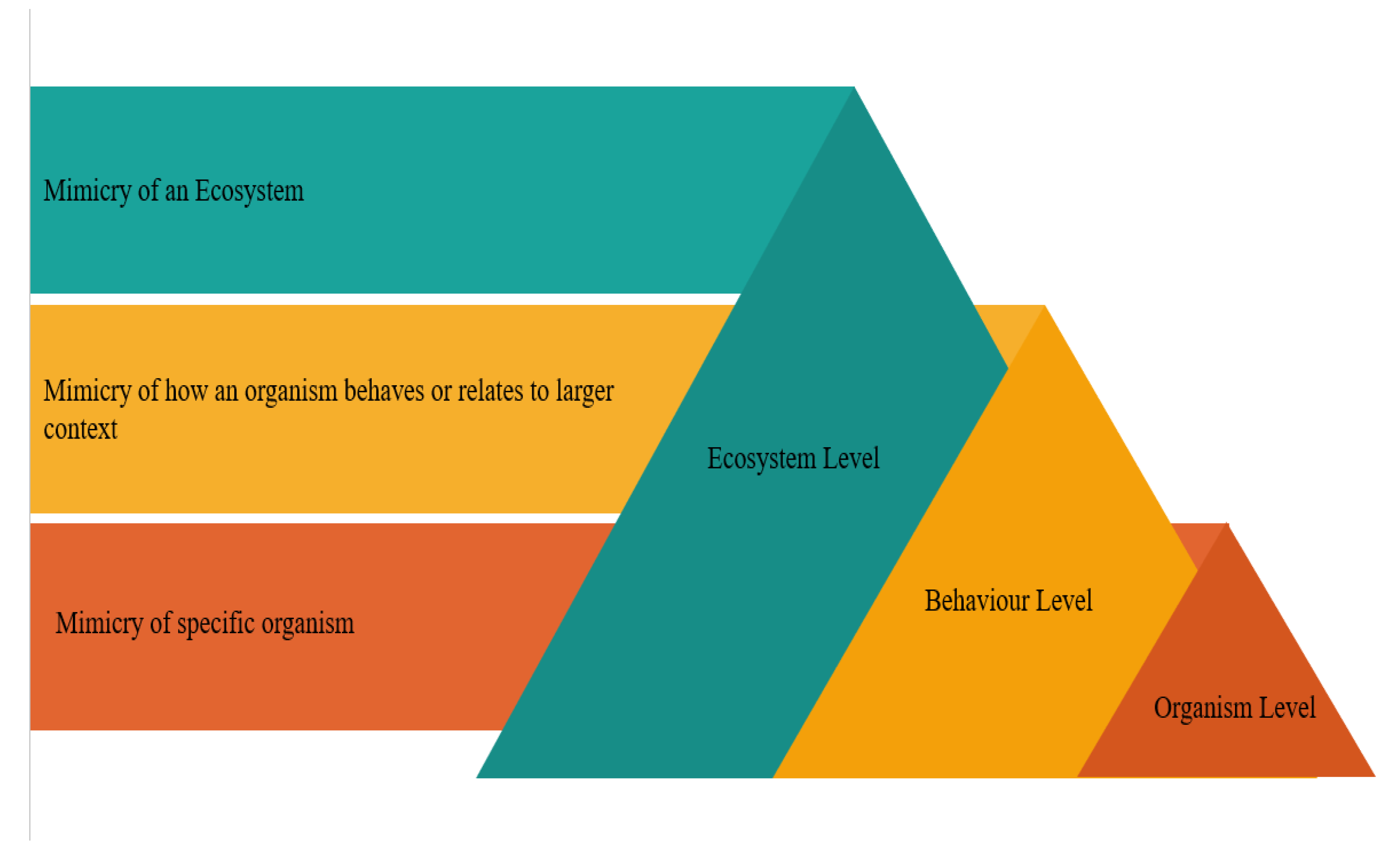

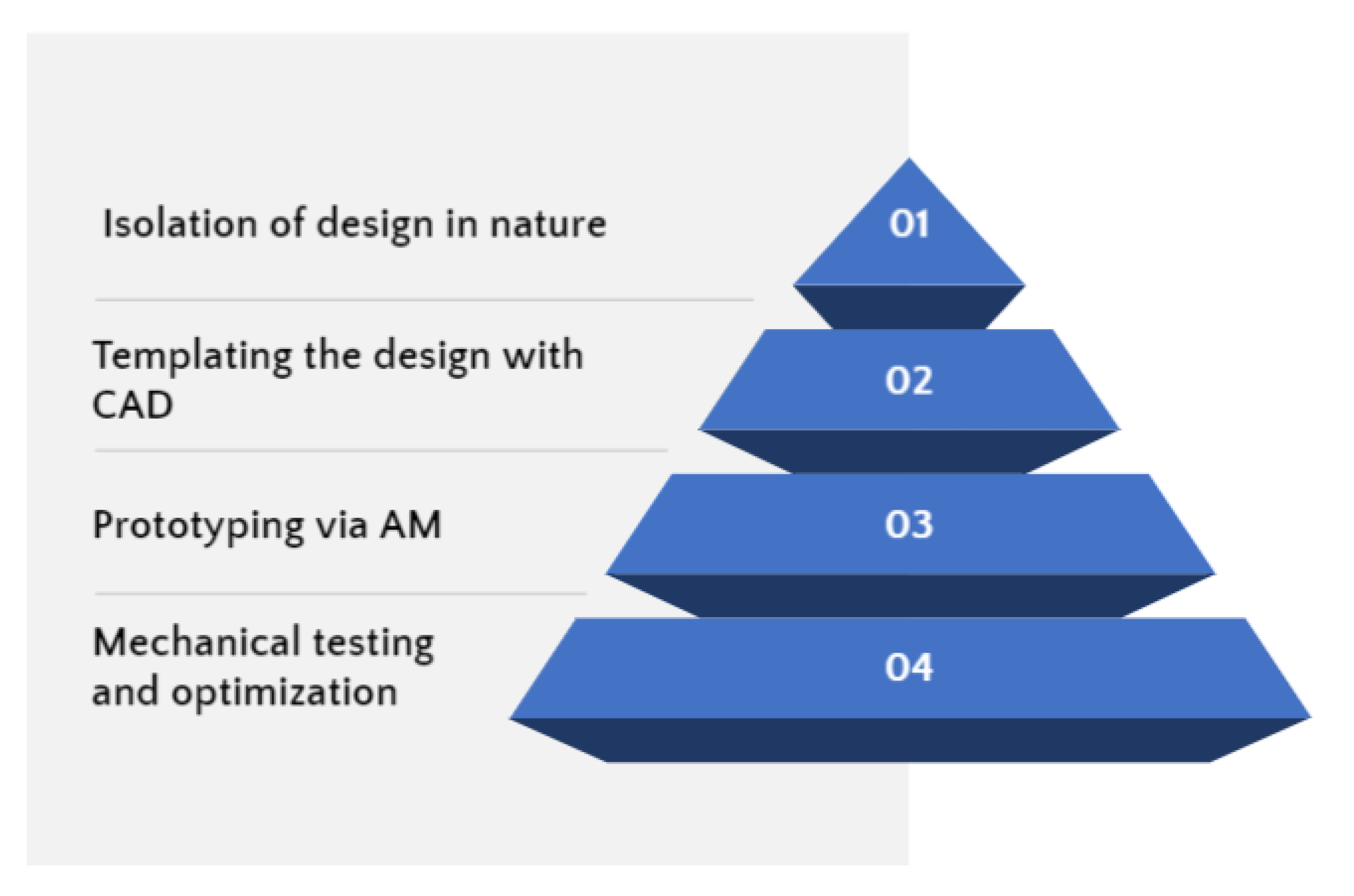
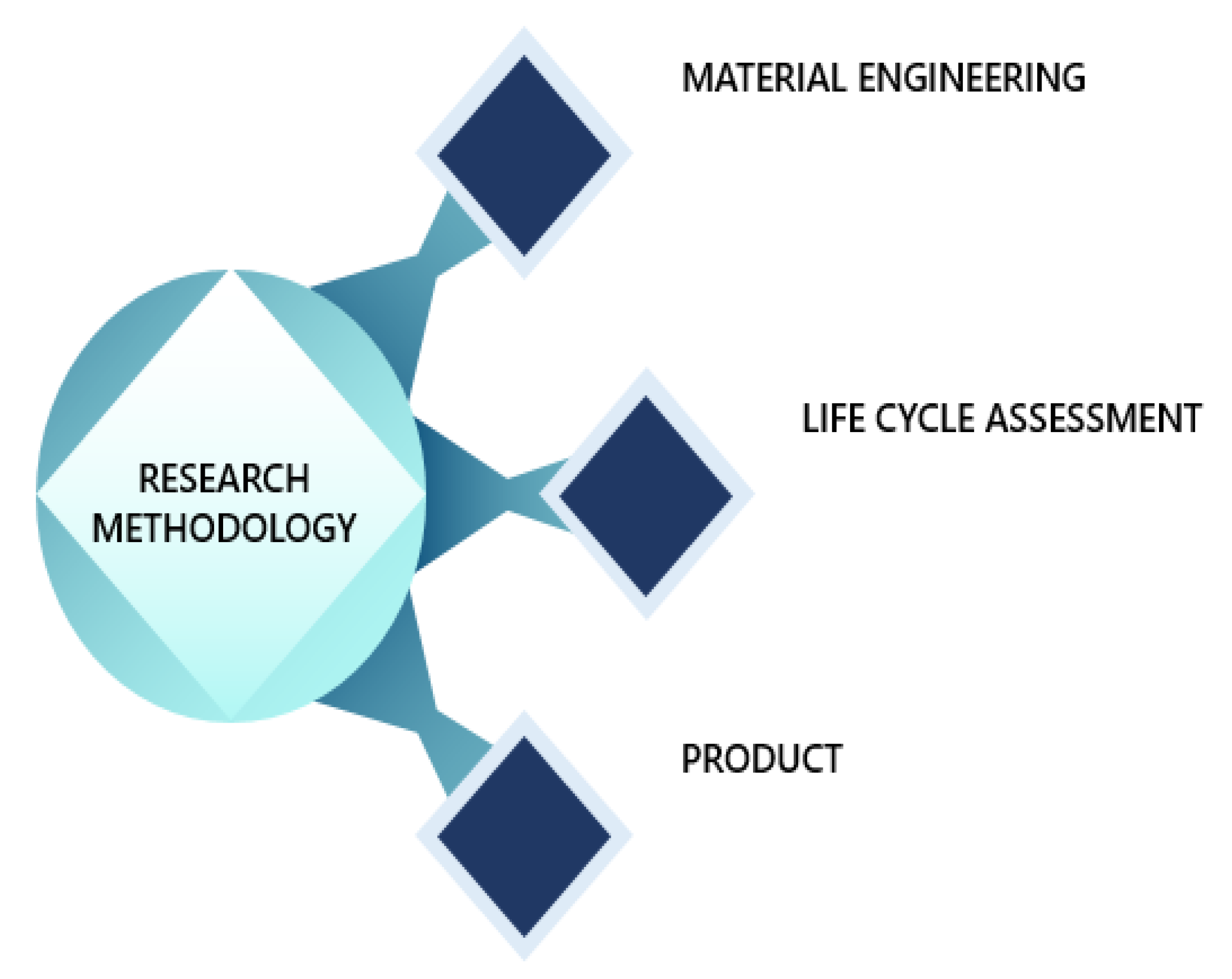
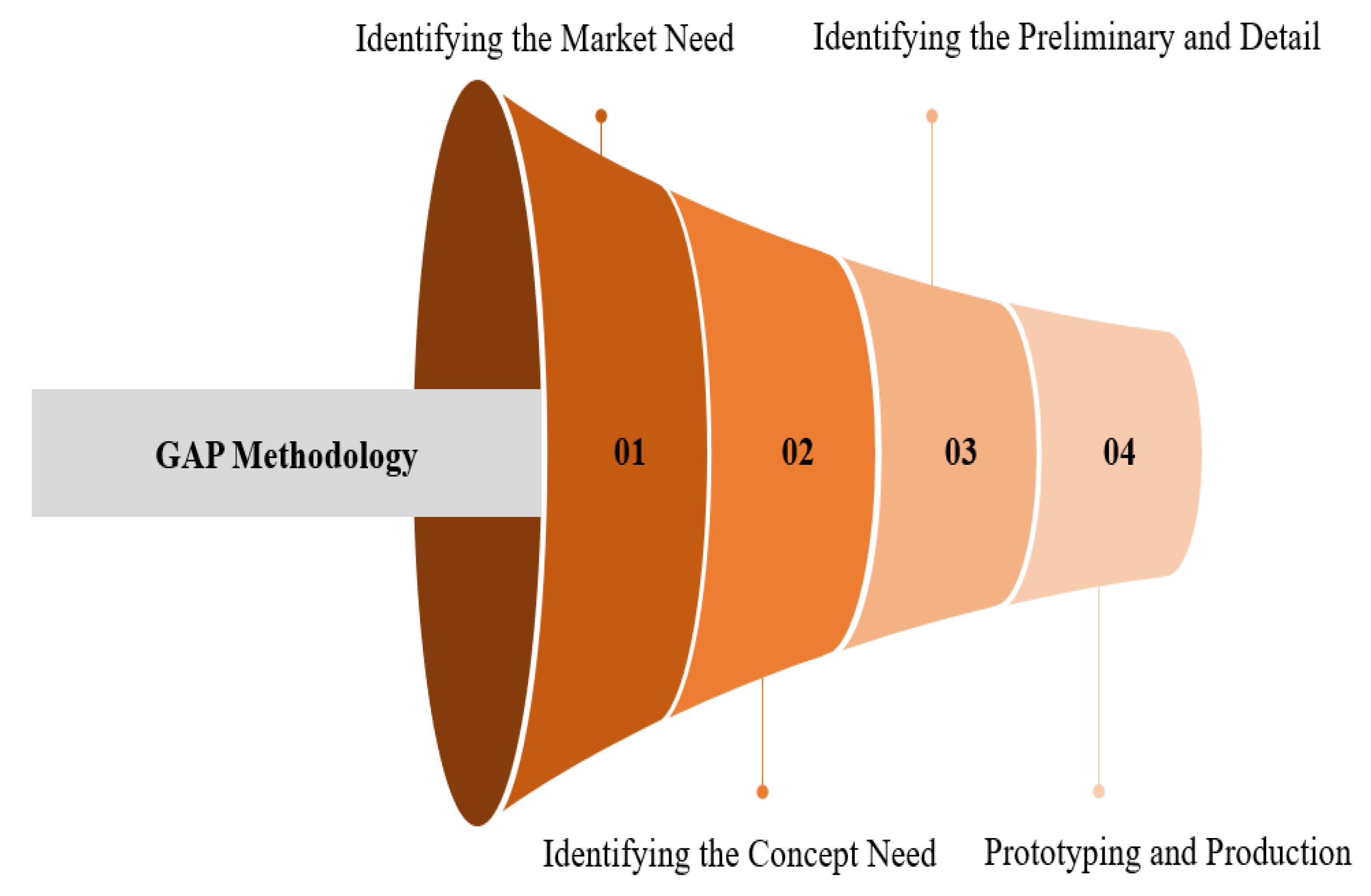
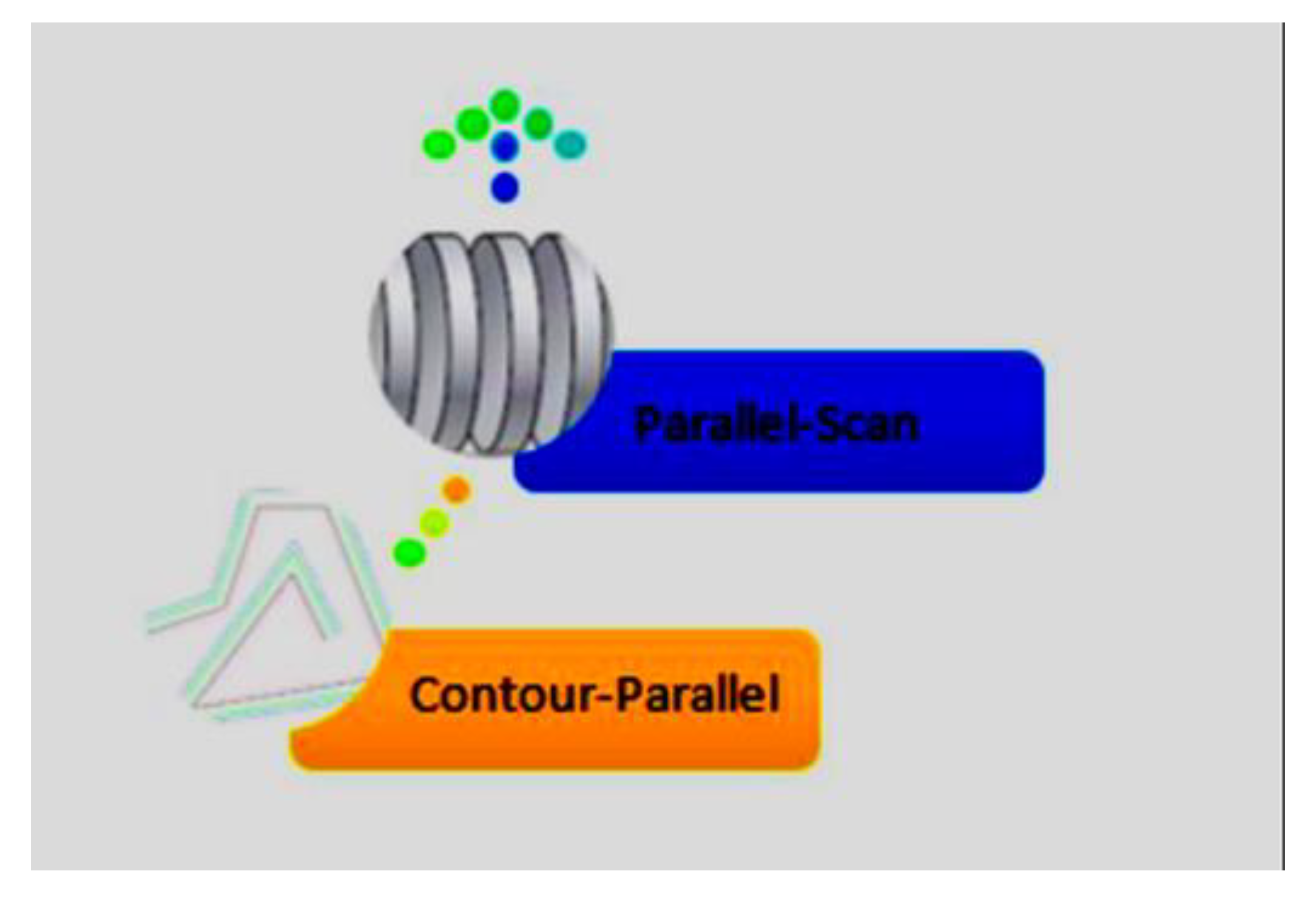
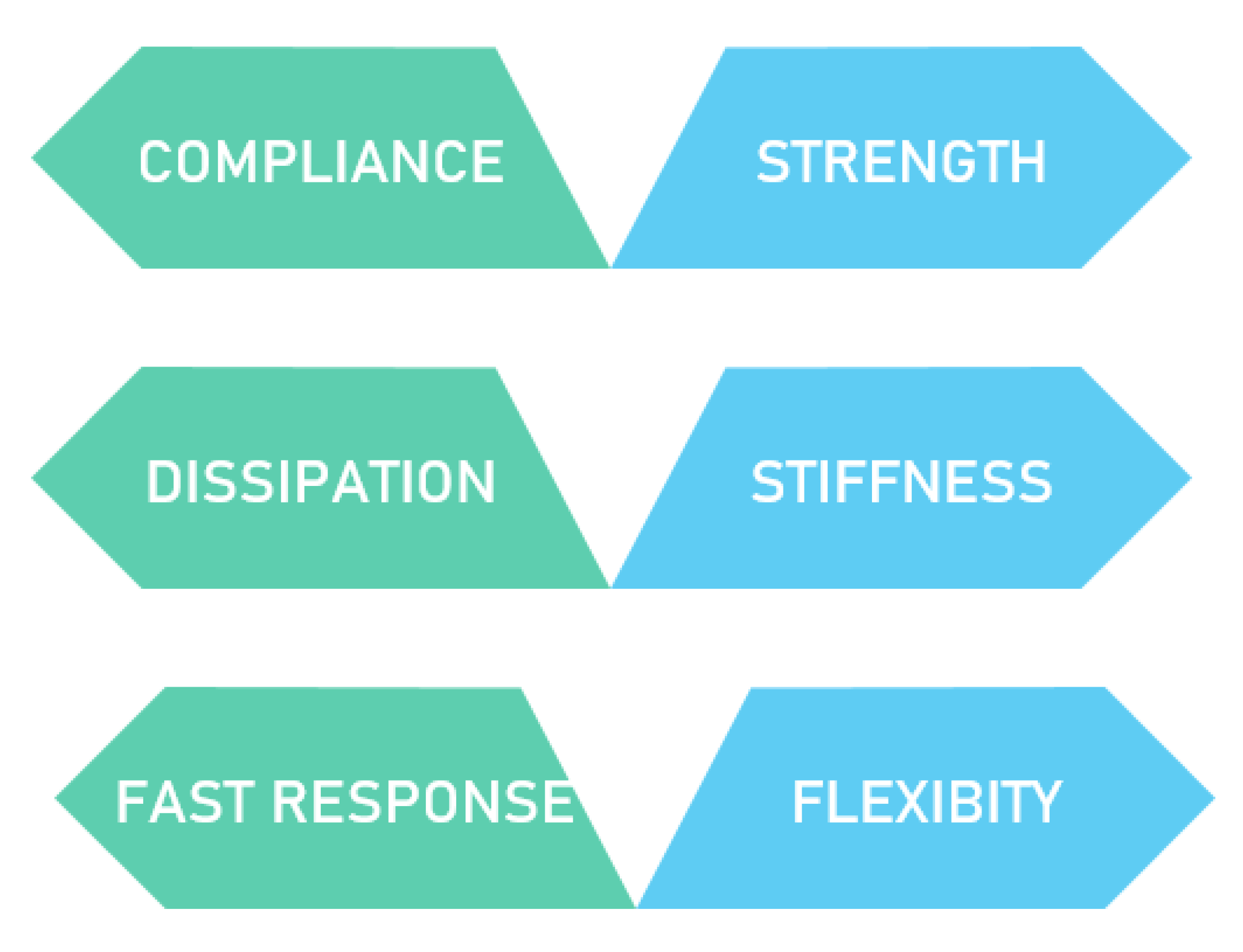
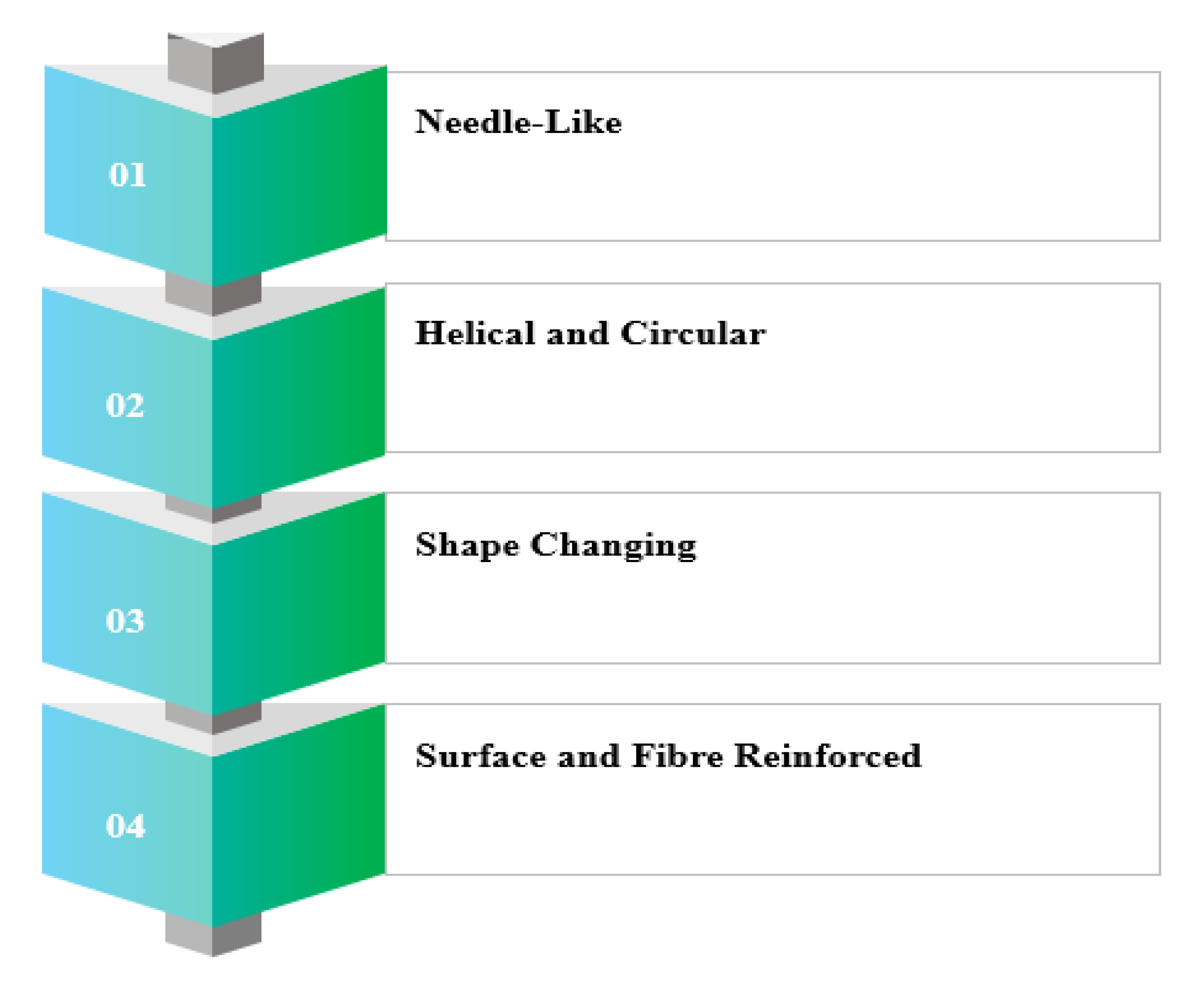

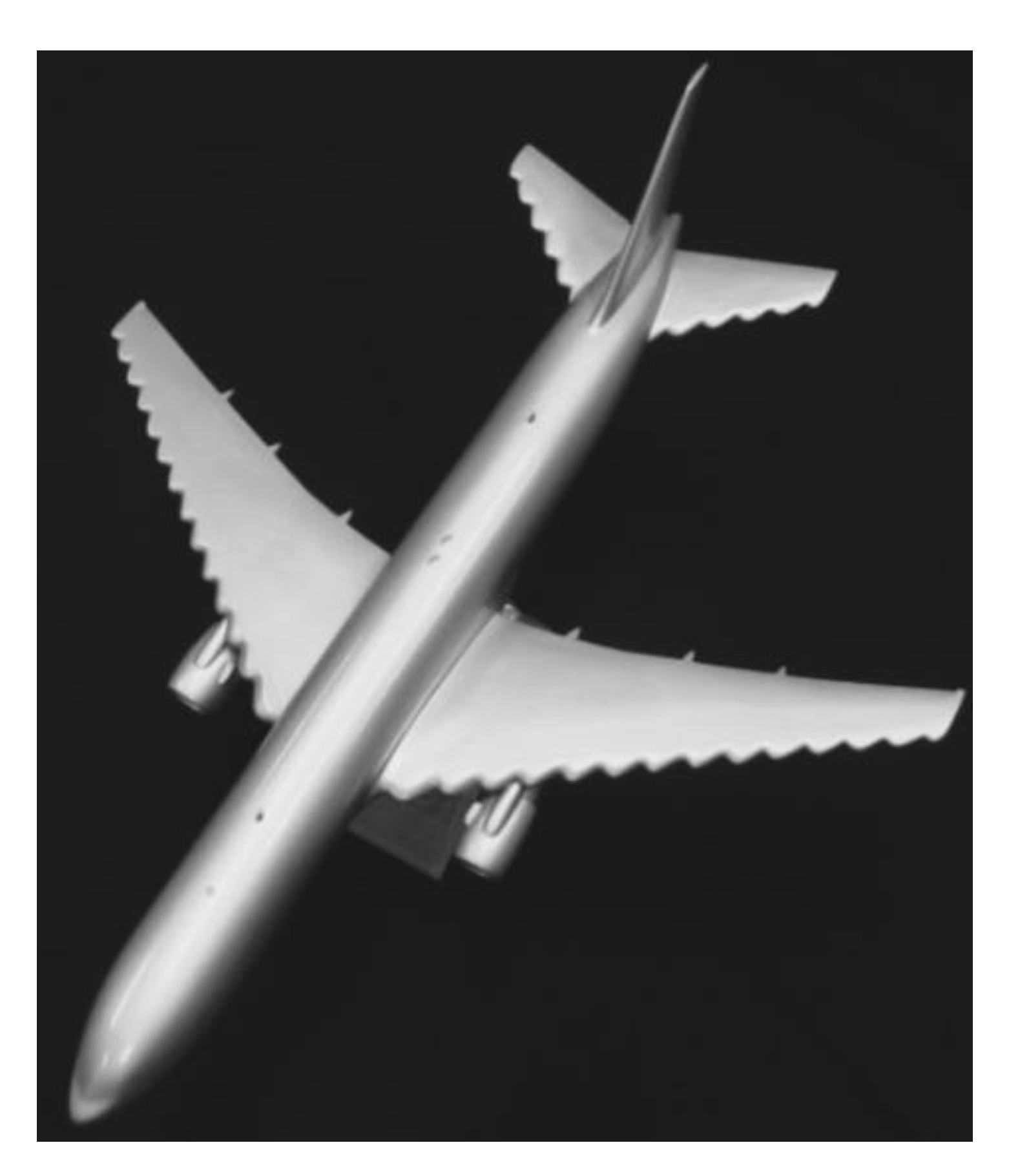
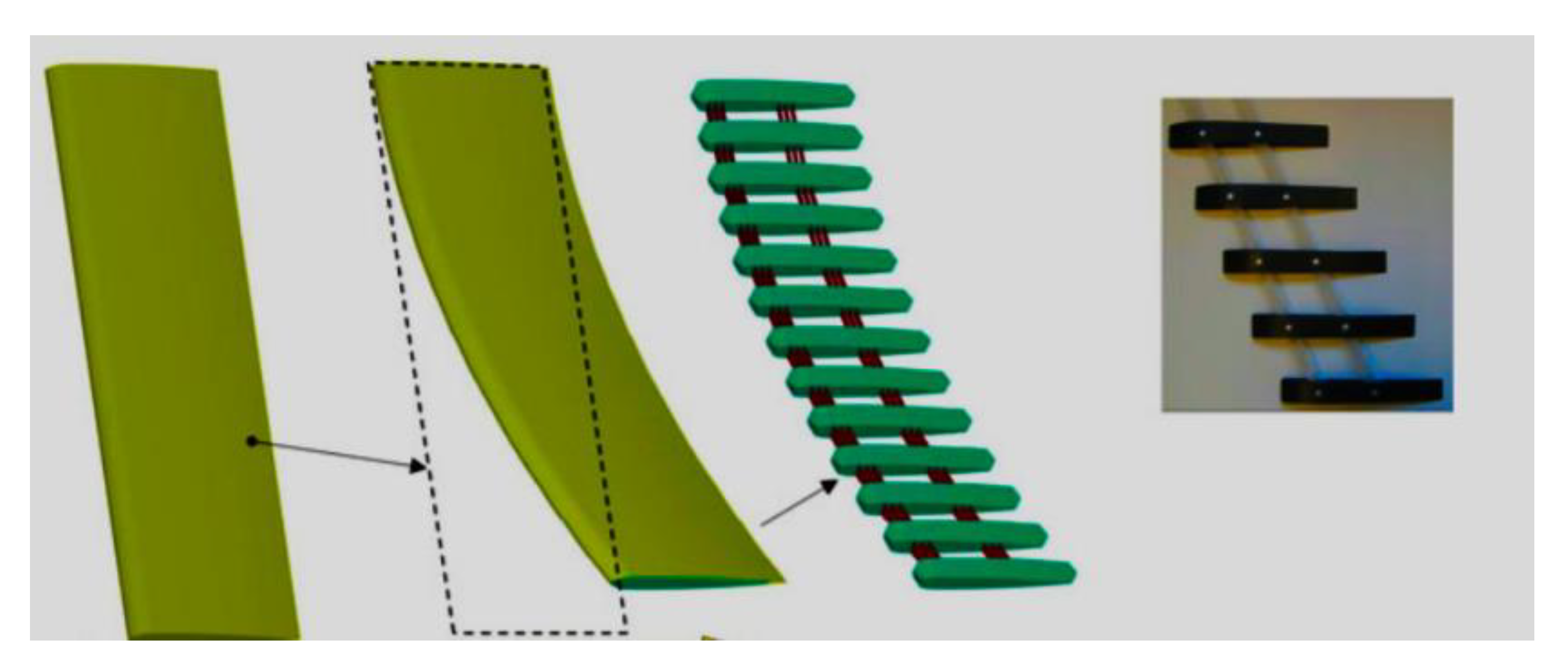
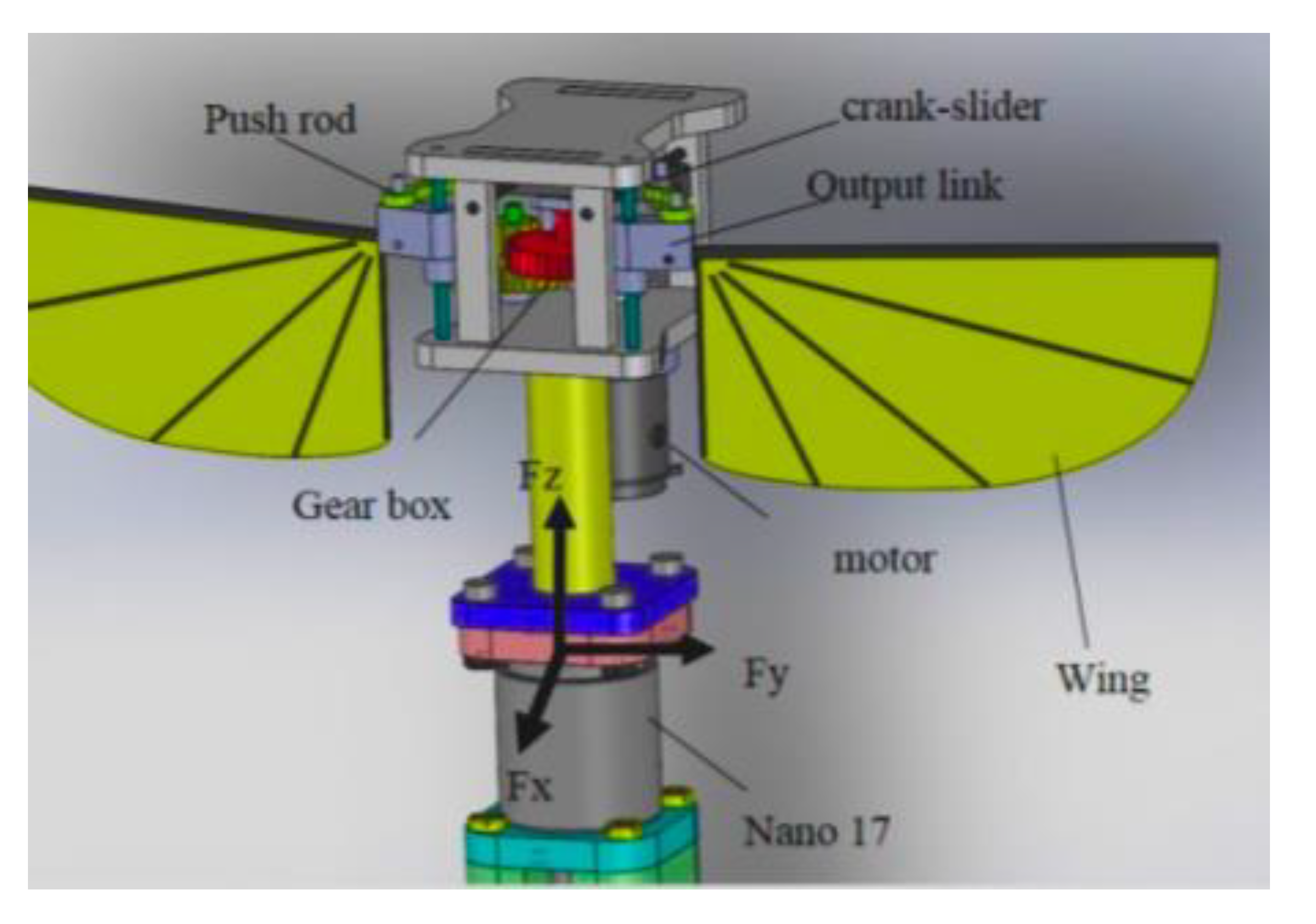
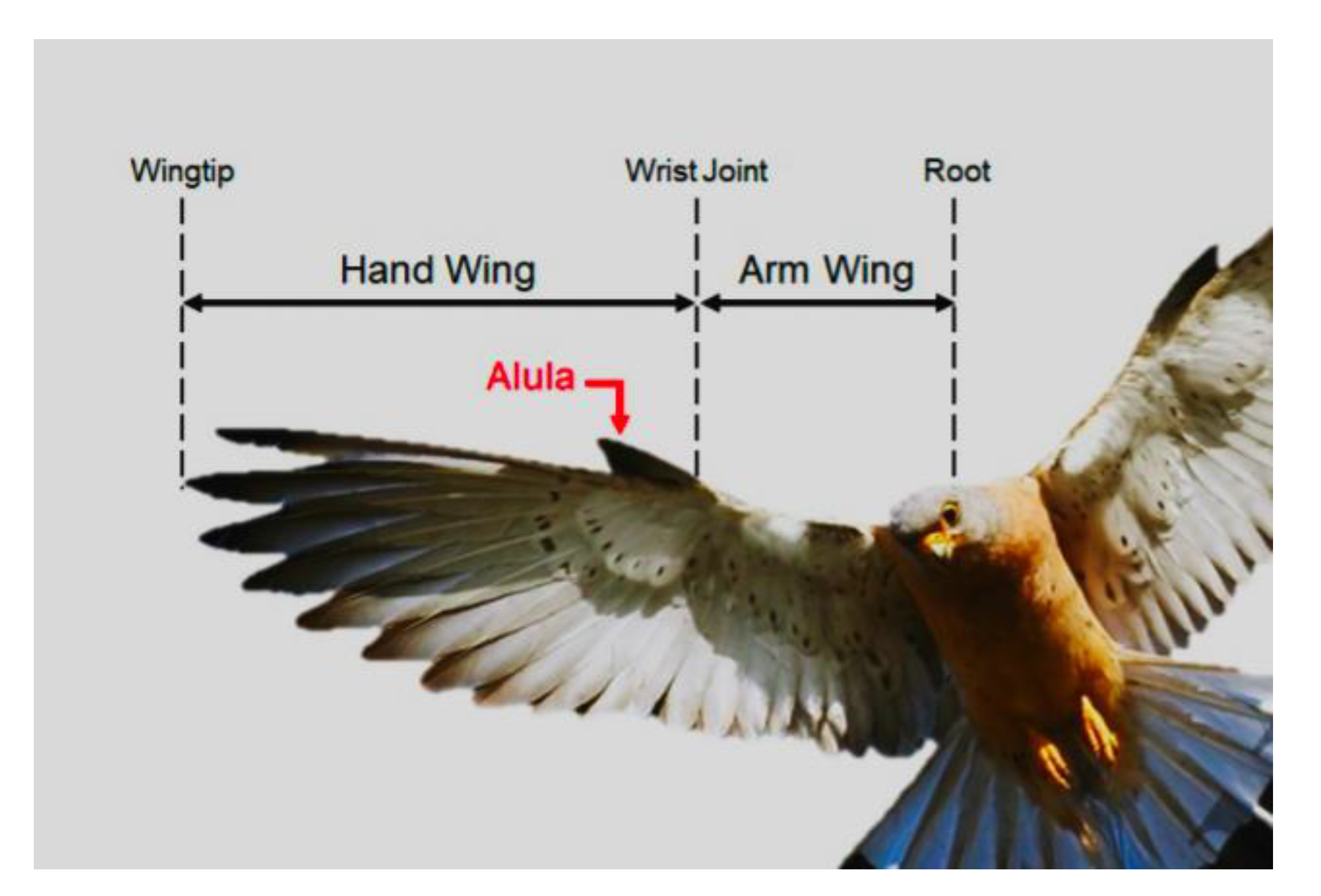
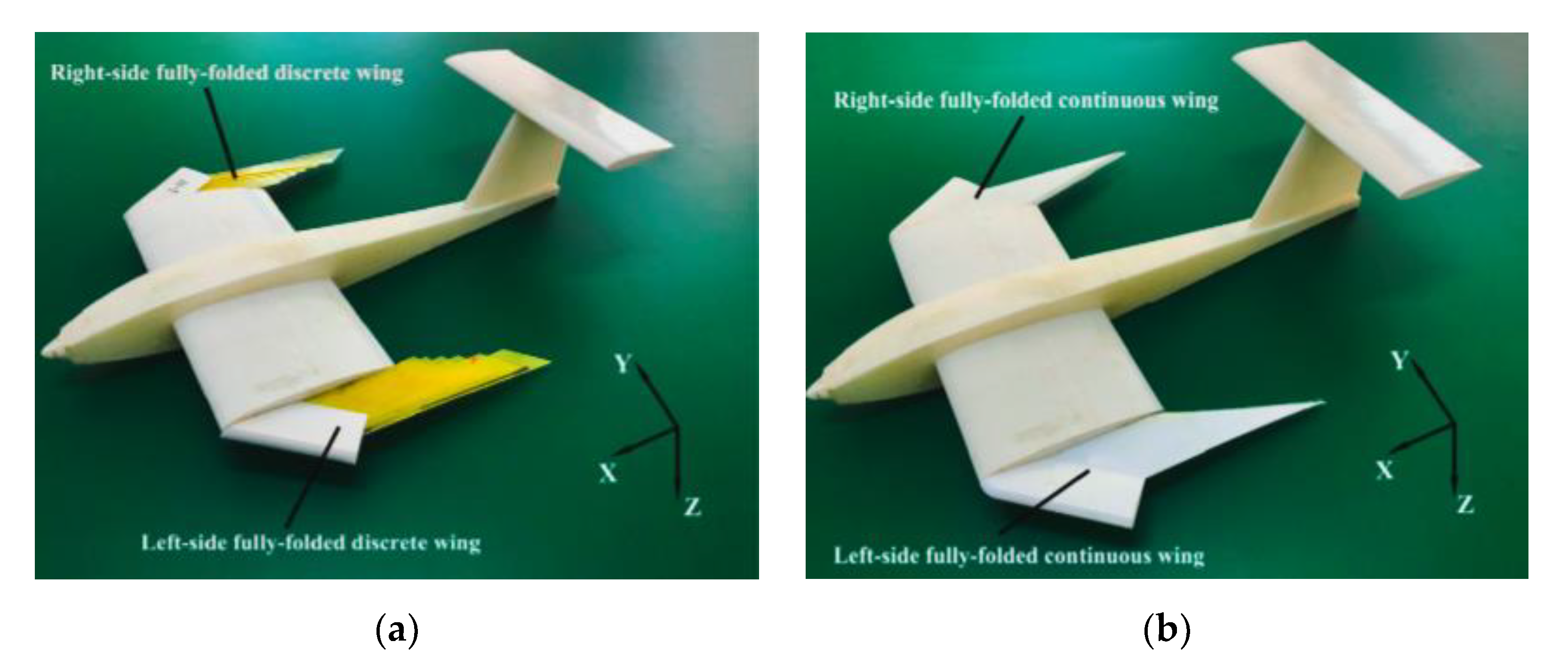

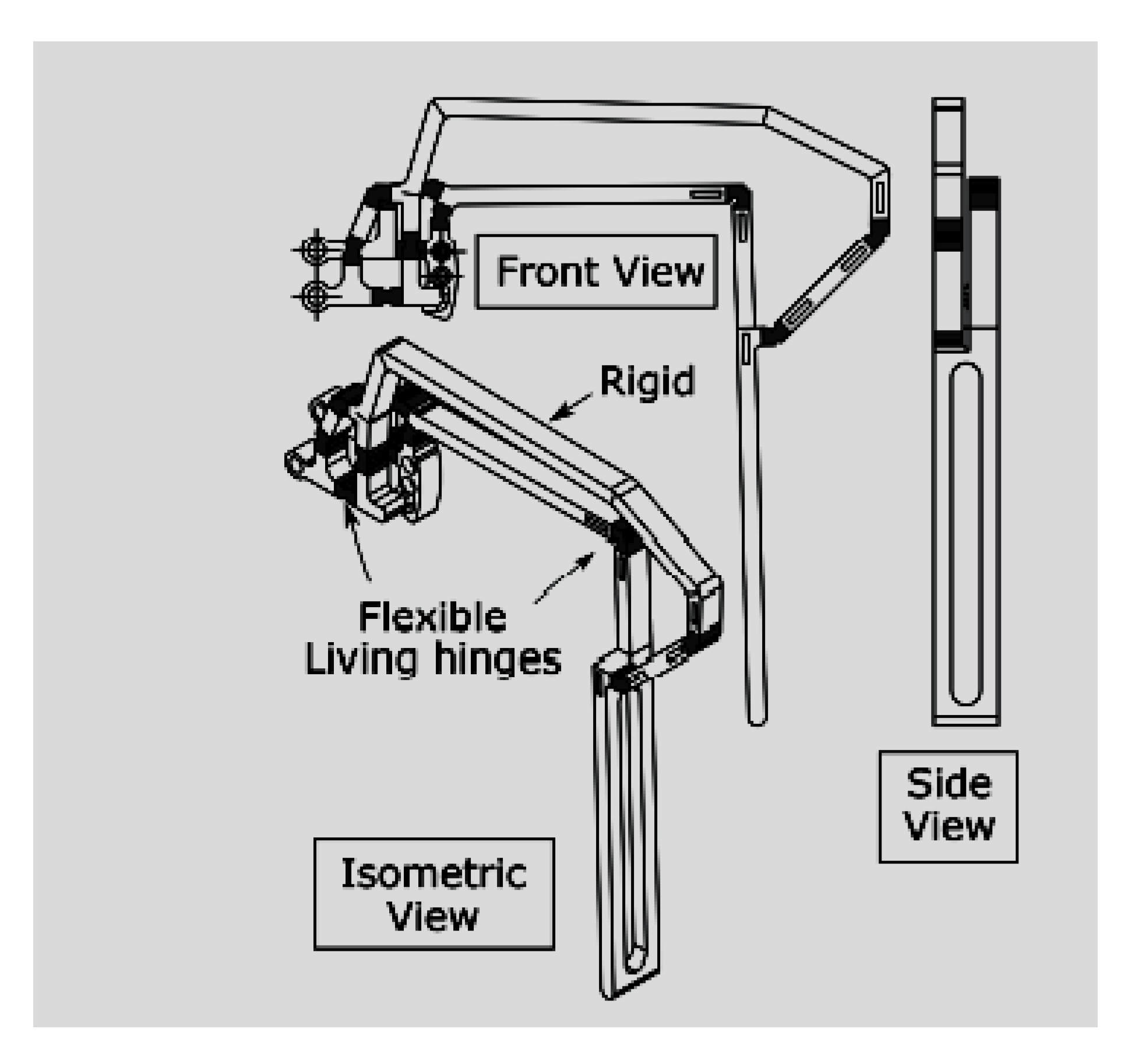
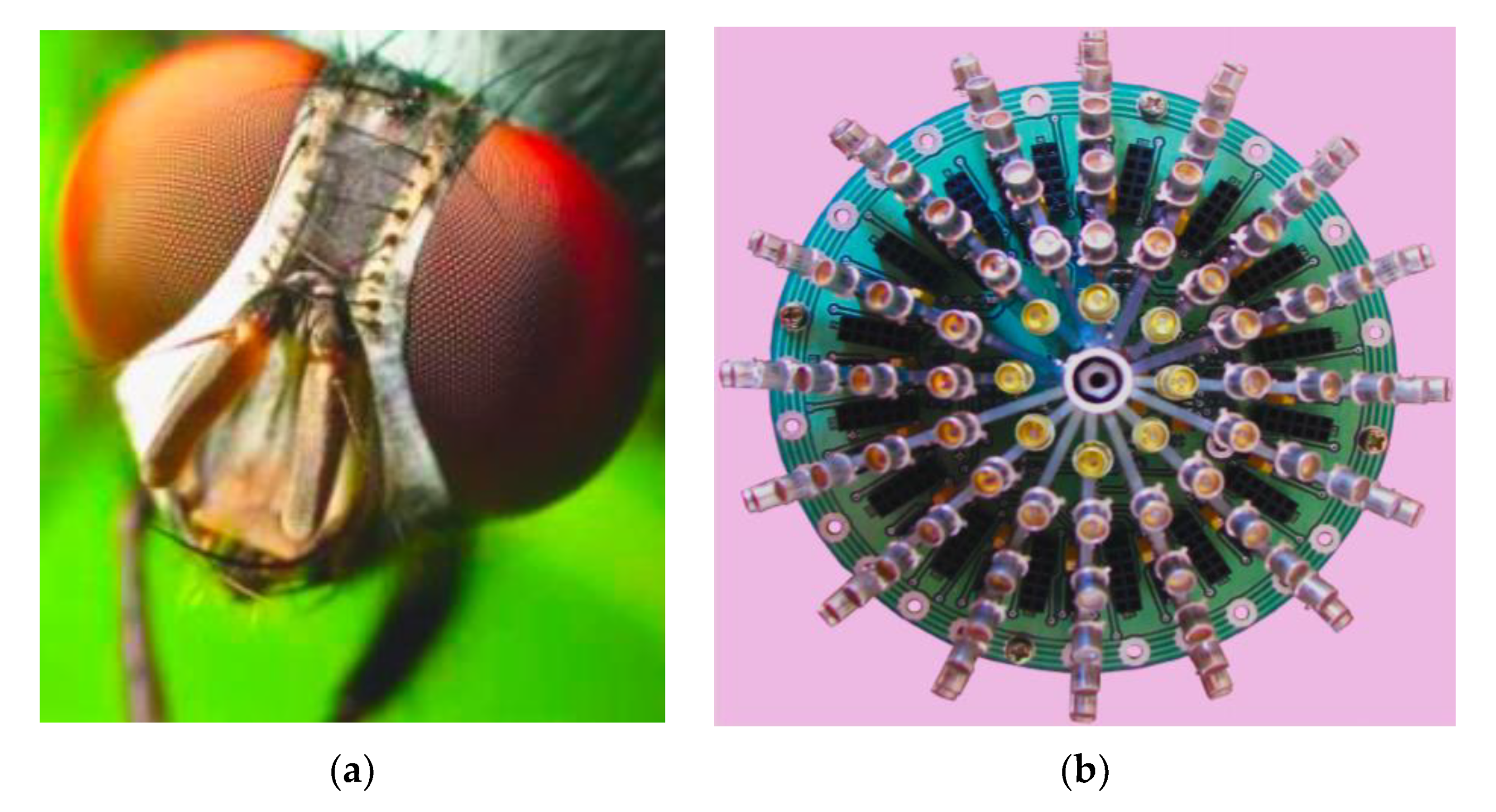
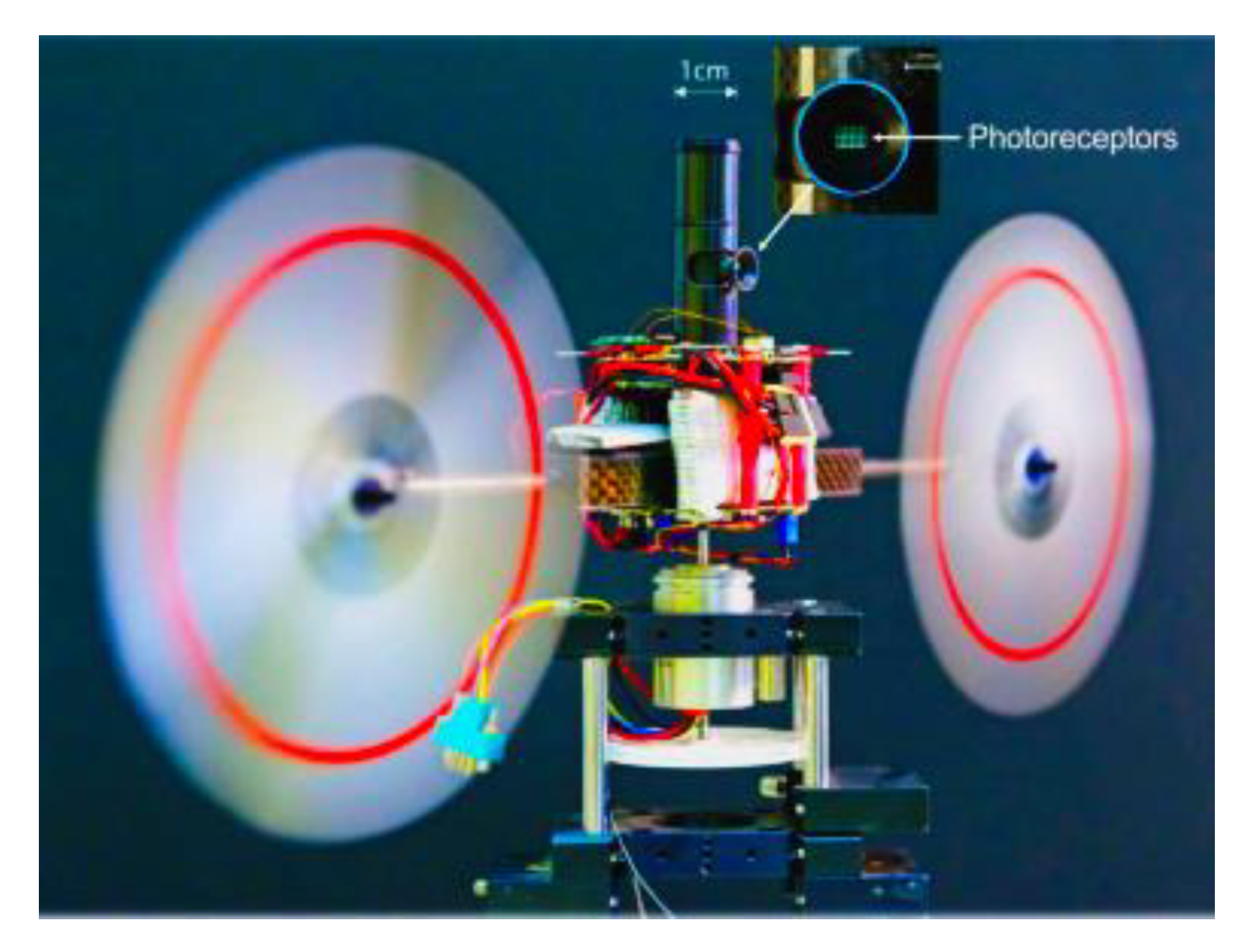
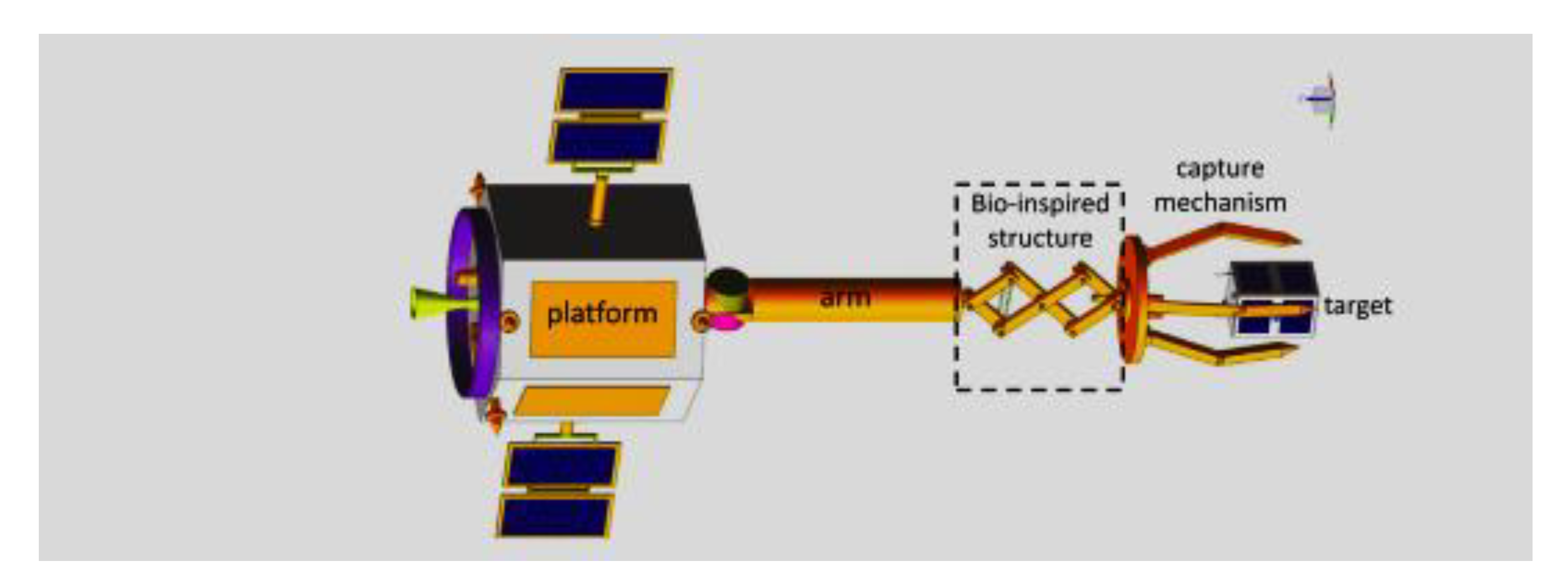

| Material | Cellular Structure | Properties | Diagram |
|---|---|---|---|
| Hair [10] | Keratin protein/Micro fibrils | Long degradation time | 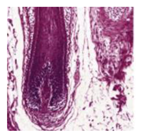 |
| Deep-Sea glass sponges [14] | Layers of silica glued with protein | Increased toughness and lightweight |  |
| Nacre and other Hybrids [20] | Platelets of calcium carbonate/Aragonite | Anisotropic material properties | 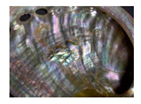 |
| Silk [21] | Long chains of amino acids | Toughness (comparable to Kevlar)/Biodegradable |  |
| Turtle Shell [22] | Rib with suture touches | Flexibility/ lower density/Higher Strength |  |
| Bone [23] | Lamellae and Osteons | Crack deflection, crack bridging, and deflection/Self-repair |  |
| Research Work | Contributions | Inferences |
|---|---|---|
| Burns et al. [25] | Investigation of T joint performance | Toughening mechanisms in tree branch joints |
| Gu [24] | Bio-inspired Composites | Use of AM technique in Bio-inspired |
| Wang et al. [33] | Fabrication of nano-graphene composites | Utilization of skin structure for material design |
| Xiang et al. [26] | Honeycomb structure under impact loading | Honeycomb structure (with circular tubes) is the best under impact loading by changing the structures’ height. |
| Feng et al. [27] | Structural effects on ABS in nanostructure mixture | Impregnating CNC on ABS, inspired by wood |
| Hogan et al. [28] | Design method for bio-inspired structure | Using FEA to optimize bio-inspired structures |
Publisher’s Note: MDPI stays neutral with regard to jurisdictional claims in published maps and institutional affiliations. |
© 2021 by the authors. Licensee MDPI, Basel, Switzerland. This article is an open access article distributed under the terms and conditions of the Creative Commons Attribution (CC BY) license (https://creativecommons.org/licenses/by/4.0/).
Share and Cite
Budholiya, S.; Bhat, A.; Raj, S.A.; Hameed Sultan, M.T.; Md Shah, A.U.; A. Basri, A. State of the Art Review about Bio-Inspired Design and Applications: An Aerospace Perspective. Appl. Sci. 2021, 11, 5054. https://doi.org/10.3390/app11115054
Budholiya S, Bhat A, Raj SA, Hameed Sultan MT, Md Shah AU, A. Basri A. State of the Art Review about Bio-Inspired Design and Applications: An Aerospace Perspective. Applied Sciences. 2021; 11(11):5054. https://doi.org/10.3390/app11115054
Chicago/Turabian StyleBudholiya, Sejal, Aayush Bhat, S. Aravind Raj, Mohamed Thariq Hameed Sultan, Ain Umaira Md Shah, and Adi A. Basri. 2021. "State of the Art Review about Bio-Inspired Design and Applications: An Aerospace Perspective" Applied Sciences 11, no. 11: 5054. https://doi.org/10.3390/app11115054
APA StyleBudholiya, S., Bhat, A., Raj, S. A., Hameed Sultan, M. T., Md Shah, A. U., & A. Basri, A. (2021). State of the Art Review about Bio-Inspired Design and Applications: An Aerospace Perspective. Applied Sciences, 11(11), 5054. https://doi.org/10.3390/app11115054








